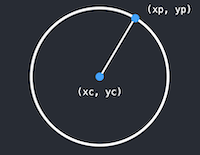Composition¶
You can define a function that calls upon other functions to do the actual work. This technique is called composition and reduces/eliminates redundancy and its associated potential errors.
Assume you want to compute the area of a circle given two points; the center of the circle and a point on its perimeter.
